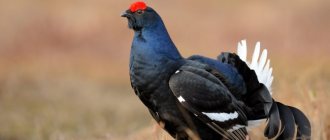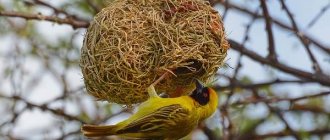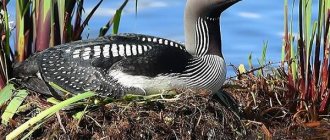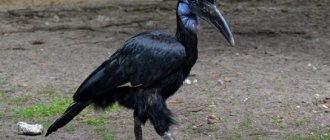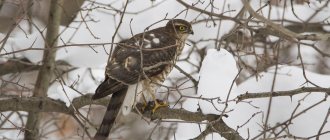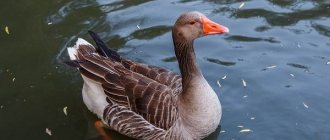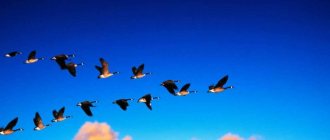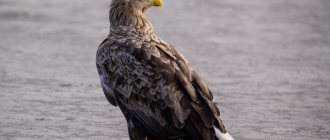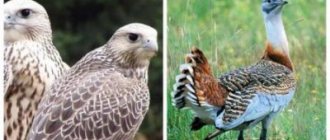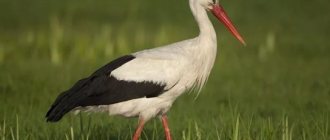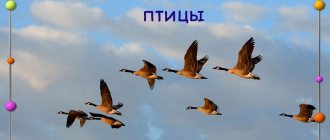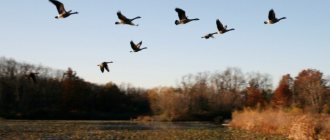Cities and semi-wild places in the Moscow region are important or even main habitats for some bird species. In this unusual environment, which is a combination of human genius and the forces of nature, a unique habitat has been created for bird species rarely found in other regions of the country.
Avifauna moves closer to human settlements by the arrival of the cold season of the year. Migrant species are found in parks; they are “city dwellers” in winter and return to nature when it gets warmer. These species do not need to fly to the warm South, because in cities it is not as cold as in the forest. Finches, goldfinches, wagtails, and cuckoos visit cities like village relatives visit people.
White stork
Large marsh bird. The plumage is white, the tips of the wings are black, the beak and legs are orange-red. The average weight of individuals is 3–4 kg. Inhabits swamps, canals, meadows and river banks.
It feeds on snakes, frogs, and fish. Does not disdain lizards. May eat small mammals or small birds. The white stork migrates from Europe to Africa for the winter.
Black stork
Similar in characteristics to the white stork. The exception is the color of the bird - it is almost all black (back, head, chest and tail). The ventral part is white. Average weight is about 3 kg. The bird lives throughout Eurasia. More often found in swamps and rivers. Arrives in Europe in mid-spring (late March - early April).
It feeds on fish, mice, insects, and mollusks. Can catch snakes and lizards.
The bird is rare. Listed in the Red Book of the Russian Federation and the CIS.
Deaf cuckoo
The bird has the standard coloration of the common cuckoo. The plumage of the male is light gray (ashy) in color. The female is brighter. She has visible red spots.
The deaf cuckoo lives in deciduous and coniferous forests and forest-tundra zones. Migration takes place in the fall in an easterly direction. Winters in the Philippines.
The bird's diet includes caterpillars, insects, and beetles. Eats butterflies, flies, spiders and chafers. In times of hunger, it can attack the offspring of other birds living nearby.
Common lentils
A small bird, similar in size to a sparrow. The head of the lentil is red, the plumage is gray-brown, and the belly is white. It breeds in Eurasia, and in winter flies to the southern part of East Asia.
Lives in densely growing forests and bushes. Can be found at the edge of a forest or near a river. It is difficult to see the bird - it is well camouflaged. The lentils give out a ringing whistle.
It feeds mainly on plant foods - berries, seeds. Rarely eats insects. Flies to wintering grounds in mid-August (from Europe to the east). Arrives in May.
Nightingale
Songbird. The nightingale is difficult to spot in the foliage. The feathered one is distinguished by its beautiful, melodic singing. The male and female have almost the same color: the abdomen is gray-white, the upper body and head are smoky brown, sandy.
Nightingales live in forest areas, in bushes, and in city parks. They feed on beetles and worms. They love spiders, caterpillars and ants. Collect seeds and berries.
Common cuckoo
A medium-sized bird (up to 600–700 g). The color is brown interspersed with dark and light shades. The cuckoo is famous for its lack of “maternal instinct.” She lays her eggs on other birds (she does not hatch them herself).
Lives in forests and swamps. It feeds on lizards, caterpillars, and beetles. Might eat a mouse.
The bird doesn't sing. She makes the familiar “ku-ku” sounds to everyone. The habitat covers many zones - from deserts to the Atlantic. Migratory bird. Winters in Africa.
Great cormorant
Large fishing bird. It has a long neck and a curved beak. The plumage color is black, the beak is white. The lower part of the body has a lighter shade. Cheeks yellow. Weight from 2 to 3 kg.
The cormorant lives in Europe, Africa, and North America. Lives on the shores of seas and inland waters. Migratory bird. Winters in the south of Crimea.
It feeds on fish (dives 4 m for it), insects and mollusks.
Zhelna
Another name is black woodpecker. Lives in the forests. It has a black color, the head (crest) is red. It feeds on insects (obtains them from tree bark). The voice is loud and melodic (reminiscent of the sound “kru-kru-kru”).
Habitat: forest-steppe of Eurasia. Loves coniferous and mixed forests, deep taiga. In search of food, the bird hollows out trees, getting beetles and larvae.
Hoopoe
Migratory, nesting bird. The representative has a bright color: the head is red, the body with wings is striped (black-brown-white). The breast and lower part have a pinkish tint.
Lives in the Leningrad and Moscow regions, in the taiga zone. Prefers open places with sparse shrubs and grass. Not afraid of people.
It feeds on ants, beetles, and caterpillars. The bird's voice sounds like "whoop-whoop-whoop." The hoopoe also hisses and squeals.
Magpie
The bird looks like a crow. The predominant color is black and white. The tips of the wings are greenish-purple, the belly is white. The tail is long. Lives in all parts of Russia. Settles in forests and parks. Makes chirping sounds.
The bird has high intelligence. She is trainable and can recognize herself in the mirror.
It feeds on forty lizards, beetles, and mice. Does not disdain carrion. Can destroy nests.
Tufted duck
Belongs to the duck family. The bird is small - weighing up to 750 g. Color - black (the male may also have white sides). The beak is short and wide. The sounds of a duck are “gyun-gyun.” It lives in bodies of fresh water: lakes, ponds, rivers.
Arrives in April, as soon as the ice melts. Spends almost all his time in the water. Dives up to 4 m deep. The blackling feeds on small fish, crustaceans, and mollusks. Sometimes eats aquatic plants.
The bird is listed in the Moscow Red Book.
Saker Falcon
Large falcon bird. Colour: The back is brown against a background of contrasting gray feathers. Habitat: plateaus, steppes of southern Siberia and the Baikal region.
The bird hunts small mammals (mice, gophers). Belongs to partially migratory birds. It is considered an endangered species - the balaban is listed in the Red Book.
Waxwing
Refers to songbirds. Outwardly it resembles a sparrow with a crest. Color: gray-pink. There is a yellow stripe along the edge of the tail. Breeds in the taiga forests of Russia, migrates to the southern parts of the continents.
The waxwing is a flocking bird. It feeds on berries, larvae, and insects. Makes trills “svi-ri-ri-ri”.
Snipe
A small dark brown bird with a long stick-shaped beak. The snipe lives in fresh or salty water areas with dense vegetation. Loves marshy areas and wet meadows.
Winters in Southern Europe, migrates to Asia. Birds eat spiders, worms, small crustaceans, seeds and plant fibers.
Golden eagle
Large bird of prey. Refers to hawks and eagles. The difference from its relatives is its “golden” head. The bird has large eyes and a hooked beak. Wingspan up to 2 meters. Weight - up to 5 kg.
Golden eagles live in open areas - on plains and foothills. The bird migrates short distances. It feeds on rabbits, mice, hares. Can grab a fox and a crane. Attacks young mammals - deer, sheep.
Northern chatter
Reed migratory bird. Appearance similar to a sparrow. The main color is gray-brown, the tummy is whitish. Habitats: dense bushes, forest edges, clearings and thickets.
The bird is listed in the Red Book of the Yaroslavl region and R. Mordovia. A little-studied species.
Burgomaster
Large polar gull (weight up to 2 kg). The color is pale: the head and chest are white, the back to the tail is grayish. The bird lives on rocky coasts and islands. The glaucous glaucous is an omnivorous bird. Loves shellfish, berries, other people's eggs and chicks. Does not refuse carrion.
Leads a semi-nomadic lifestyle. Winters near the nest.
Woodcock
Nocturnal migratory bird. Lives in swampy areas. Loves old, damp forests and wastelands. Woodcock is a solitary bird (it rarely forms groups). Is the object of hunting.
Woodcock is the size of a pigeon. It has a straight beak and a mottled brown-orange color.
It feeds on larvae, beetles, spiders, and worms. Rarely eats plant foods (corn and oats).
Bluethroat
Gray passerine bird. Males have a brightly colored breast. Females are gray-brown in color with a dotted necklace on the chest.
The voice is like a nightingale. The bluethroat can interestingly copy the sounds of many birds.
It lives near rivers (with abundant, dense vegetation and bushes along the banks), in meadows and near swamps. It is a migratory bird, but does not form a flock.
Great godwit
A large sandpiper with a small head and a long, needle-like beak. The bird's head and neck are brown, its belly is white, and the rest of the body is a dirty brown-gray hue.
Loves damp lowlands, swamps - places with high humidity. The bird is listed in the International Red Book, but is hunted in Russia.
It feeds on insects, frogs and worms. Loves crustaceans.
Godwit
A copy of the Great Godwit, only with a small neck and short beak. Migratory bird. The distribution area, habitats and nutrition are similar to its larger brother described above. The security status is not of concern.
Wryneck
A small bird from the woodpecker family. It is migratory and spends the winter in Africa. It is called the whirlwind because of its unusual behavior - when it is picked up, it fluffs up and rotates its neck.
The color is cuckoo with brown-white-black splashes. On the head there is a crest of the same color. The abdomen is gray-white.
Loves deciduous and mixed forests - lives in old trees. Feeds on insects.
Nuthatch
An active and noisy bird (makes whistles, gurgles and other sounds) from the passerine family. There are many species of nuthatch. It is the species that determines the color of the bird. The predominant colors are blue-gray back and gray belly.
The bird feeds on plant and animal food (beetles, butterflies, larvae, nuts, seeds). Loves to live next to a person. Easily gets used to hands.
House sparrow
A classic sparrow, which is distributed throughout Russia (especially in urban areas). The main color of the feather cover is brown, the belly is gray, the back and head are brown-black.
The bird has settled down well next to humans. It feeds on vegetation and insects.
field sparrow
The bird is similar to a house sparrow, but lives further from humans - on the outskirts of the city, near plantings and vineyards. Loves bushes and thickets.
Slightly smaller in size than the brownie, the color is more saturated.
The tree sparrow is a flocking bird. Leads a sedentary lifestyle. It feeds on seeds and insects.
Great tit
It is also a well-known bird that lives in many Russian cities. It has a yellow belly and a black tie. The bird's cheeks are white. It is similar in size to a sparrow.
In the summer it lives in the forests, but with the onset of winter it flies to the city (to feed).
In summer, tits eat caterpillars, beetles, butterflies, and spiders. They love plants and berries.
Long-tailed tit
This representative is very different from the ordinary tit. The bird's tail is long. Color: head - white, back - gray-pink, belly - white-gray-pink. Has abundant downy cover.
The tit lives in the forest, near rivers and in park areas. Loves bushes. It feeds on insects and plant fruits.
Crow
The general name of a variety of species category. There are many types of crow - black, big-billed, gray, etc. Each of them has its own coloring and behavior.
Crows spend the night in a group, gathered in a large group. They also obtain food.
They are easily tamed by humans and can be trained.
Gray Crow
Large, black and gray bird. Considered a singer. She is distinguished by reasonable behavior - she is very sociable, protects her family, and forms packs.
It feeds on animal food (beetles, caterpillars, mice). May eat carrion. In the city limits he finds food in garbage dumps.
Great bittern
The largest specimen in its family (up to 2 kg). Cuckoo-colored plumage. Thick, elongated neck. Lives in reed thickets and places with standing water. Loves mild climates. Single.
The bittern feeds on eels, fish and invertebrates. Screams loudly “trum-u-trum” at night and in the morning.
Wood Pigeon
A bird from the pigeon family, widespread throughout Russia. Cautious. The color is blue or grayish. Makes cooing sounds “kru-ku-kru-kru”. Loves nature, villages.
Feeds on seeds. Rarely eats insects. It is an object of sport hunting. Because of this, its numbers are gradually declining, but the bird is not under protection.
Blue tit
A small bird that looks a bit like a tit. It has yellow belly plumage, white cheeks, and gray back. Loves to live in gardens and parks. Finds food in feeders. He easily lets people approach him.
In the wild, it lives on the edges of the forest and feeds on worms, beetles, and berries.
Red-throated loon
It is the smallest of its kind. The main color is brown, the head is gray, the belly is white-gray. There is a red-orange spot on the neck.
Loves fresh ponds, swamps and overgrown lakes. He cannot stand the presence of people and leaves his home at lightning speed.
The loon feeds on small and medium-sized fish, frogs and insects.
Large birds of prey
Great bittern
Belongs to the order of ankles. The bird reaches 80 centimeters in length, and its wings open to 135. Small specimens weigh a kilo, and large ones weigh 2 times more. All have short, wedge-shaped tails. Bitterns are also distinguished by long legs with elongated and clawed toes. They and their paws are generally greenish. The bittern's plumage is beige-yellow with brown spots.
Living near bodies of water, the bittern feasts on leeches, worms, fish, larvae, and insects. On the shore, the bird sometimes catches lizards.
Listen to the voice of the bittern
The great bittern is often called the marsh bull for the sounds it makes.
Golden eagle
Belongs to the hawk-like species. The length of the bird is 90 centimeters. The wingspan often exceeds 2 meters. A golden eagle can weigh up to 7 kilograms. Females gain this mass because they are larger than males. This is an expression of sexual dimorphism.
A distinctive feature of the bird is a necklace of elongated feathers at the neck. They, like the rest of the predator’s color, are brown, sometimes almost black. There are light markings on the bottom of the wings and on the belly of the bird.
There are 7 species of golden eagles in nature. There are 2 in the Moscow region. One inhabits the vast expanses of Europe, western Russia and Siberia. The other one does not fly further than the Caucasus. Both species are wintering birds in the Moscow region .
Merlin
Included in the falcon family. The length of the animal is 60 centimeters. The wingspan reaches 180. The bird weighs 1-2 kilograms. Like golden eagles, sexual dimorphism is developed. Females are larger. Distinctive features of representatives of both sexes are pointed wings, yellow legs, and a combination of brown, white, and gray feathers on the body.
Gyrfalcons eat other birds by swooping down on them. Predators choose small birds. White partridges are especially “loved” by gyrfalcons.
Burying ground
Belongs to the hawk family. The body length of the animal reaches 90 centimeters. The wingspan of the burial ground is more than 2 meters. Females of the species weigh up to 5 kilograms. Males can weigh 2 kilograms. Along the edges of the birds' wings and tail are brown-black feathers. Otherwise they are light brown. The beak of the predator is yellow. The paws of the burial ground have the same tone.
In the photo, birds of the Moscow region often tear apart carrion. It is the basis of the diet of burial grounds. Hence the name of the birds. About a third of their diet comes from self-killed, or rather “self-pawed”, killed gophers, jerboas, hares, rats and small birds such as partridges.
The addiction to carrion is associated with difficulties in hunting. Among other eagles, the Imperial Eagle is the weakest and most inactive. This is what makes it difficult to catch live game.
White-tailed eagle
Member of the order Falconiformes. The length of the bird is 90 centimeters. The wingspan exceeds 2 meters. The bird can weigh up to 7 kilograms. The animal is distinguished by its white and shortened tail. It is wedge-shaped. Except for the tail, the eagle is brown. The head is slightly lighter than the body of the bird. Her beak is yellow, light in color at the base and rich in color at the curved tip.
Unlike eagles, bald eagles, of which there are several species, have unfeathered bases of their legs. In addition, whitetails are larger than their relatives.
The eagle got its name from its white tail plumage.
Peregrine Falcon
Belongs to the falcon family. The peregrine falcon is relatively small, slightly larger than a crow, weighing a little less than a kilogram. The wingspan reaches 110 centimeters. A distinctive feature of the bird is its prominent keeled chest. She and most of the neck are white.
The back of the bird is slate-black, the sides and wings are gray. The peregrine falcon's beak is yellow with a black tip and is short in length.
In Egyptian mythology, the bird was a prototype of the Sun God. During the ancient kingdom, peregrine falcons were common. In the 21st century the population is threatened with extinction. Meanwhile, the peregrine falcon is the fastest among birds of prey. To reach speeds of up to 322 kilometers per hour, the predator chooses the open spaces of the steppes to live.
The peregrine falcon is the fastest among birds of prey
Corncrake (Crex crex)
It is distinguished by its small size and camouflage plumage. The corncrake has a dense build, an elongated neck and a rounded head of a reddish-ochre color. It is slightly larger in size than a blackbird. The weight is 80-200 grams, the wingspan is on average 50 centimeters.
The corncrake is a migratory bird; in winter it flies to Africa. It is noteworthy that during its life the bird prefers not to fly, but during migration it is able to cover long distances by air.
The corncrake is quite difficult to see, since it lives in tall grass and leads a secretive lifestyle. Even in case of danger, she would rather run away than fly away. The corncrake feeds on insects, greens and small insects. The bird nests near swamps and wet areas.
Previously, the corncrake was on the verge of extinction, but over time the situation improved and today it lives quietly in the Moscow region.
Large omnivorous birds of the Moscow region
Rook
Belongs to the corvid family. The rook reaches half a meter in length and weighs about 500 grams. Being related to crows, the bird resembles them in its black and shiny plumage, body structure, and size. However, the rook has a light rim around its beak, and the beak itself is smaller than its relatives.
From animal food, rooks eat insects and mice. Near bodies of water, birds feast on crustaceans. Rooks recognize vegetables, seeds and berries as part of their plant diet.
Crow
This representative of the corvid family reaches 65 centimeters in length. The bird weighs up to one and a half kilograms, larger than an ordinary crow. In addition, the plumage of the latter is gray and black. The color of the raven is uniformly dark.
Crows imitate outside sounds and voices no worse than parrots. Individuals living in captivity imitate the noise of a toilet flush, a car engine, an electric razor, and repeat the words and phrases they hear.
In nature, this skill helps crows ward off danger from themselves and their chicks. By imitating the voices of foxes and wolves, crows mislead uninvited guests.
Mute Swan
Belongs to the Anseriformes. The length of the bird reaches 180 centimeters, and its weight is 20 kilograms. However, most representatives of the species gain weight of about 12 kilos and stretch only 120 centimeters, taking into account the length of the neck. The wingspan of an average individual is approximately 2 meters.
The mute, like other swans, is listed in the Red Book. Among related species, the bird stands out for its snow-white plumage and red beak with a black upper beak. By lowering its neck under the water, the mute fish nibbles algae and other plants in a pond or river. If there are invertebrates on the greenery, they are also eaten.
When swans fail to have offspring, the parent couple continues to care for their already grown children for a second year
Coot
Belongs to the rail family. The bird is the size of an average duck and weighs about a kilogram. The name of the birds of the Moscow region is associated with a bare forehead. There are no feathers on it. The skin on the forehead is white. It appears to be a receding hairline.
The coot's beak is also white. The rest of the body is gray-black. The head and neck are a couple of shades darker. The legs deserve special attention. Waterfowl do not have webbing between their toes. Instead, coots developed skin folds that open up in the water. The outgrowths are not connected to each other.
The membranes of waterfowl prevent them from moving briskly on land. The skin folds of coots are comfortable both in the water and on the shore.
Coot with chicks
Mallard
It is the largest among wild ducks, stretching 62 centimeters in length and weighing approximately 1.5 kilograms. These are indicators of males. Females are slightly smaller and more modestly colored, mostly brown.
The drakes are colorful. The head is blue-green. The drake's chest is brown-red. The back and belly of the bird are gray. The wings have deep blue inserts.
Mallards are birds of the Moscow region that do not freeze in winter. At least the birds' paws don't feel the coolness. There are no blood vessels or nerve endings in their legs. Therefore, ducks calmly walk on snow, ice, and swim in icy water. There, mallards catch small fish and pluck underwater plants.
Oriole (Oriolus oriolus)
Photo: Imran Shah / www.flickr.com
This bird is easy to spot due to its bizarre color - the oriole has yellow-black plumage and an elongated body structure. However, this feature also attracts natural predators – the enemies of the oriole.
The oriole is a small bird: weight – 50-90 grams, wingspan – approximately 45 centimeters. Very active, she almost never sits in one place, and her flight speed reaches 70 km/h.
Most often, the oriole lives on the tops of trees, mostly deciduous, and prefers moderate temperatures. Found alone or in pairs. Mainly feeds on insects and berries.
The Russian name of this bird is supposedly the same root as the word “moisture”, and in ancient times it was considered a harbinger of rain.
Large vegetarian birds
Capercaillie
The largest in the Tererevina family. The bird's body length is 70-80 centimeters, and its overhang is 5 kilograms. Sometimes there are 10-kilogram specimens. They, like other wood grouse, are brightly colored. The chest has a metallic green tint. The neck has the same glow, but bluish. The back of the bird is speckled gray.
The wings of the capercaillie are gray-brown. The feathers on the tail are blue-black. Males have scarlet eyebrows that swell in spring. They attract females. During the current, their chosen ones lose their hearing. Hence the name of the bird.
Listen to the capercaillie talk
Hunters take advantage of the deafness of birds in the spring. The capercaillie population is under threat, especially in the Moscow region. There are few coniferous forests, beloved by wood grouse, where the animals feed on pine cones and twigs. In deciduous forests there are no large grouse at all, and in mixed forests they are rare.
White-tailed eagle (Haliaeetus albicilla)
This is a fairly large bird of the hawk family. Its weight reaches 7 kilograms, and its body length is 90 centimeters. The eagle differs from other birds of prey by its large and powerful beak.
The bird has a brown color, a pure white tail and a yellow beak. Younger individuals have a brown tail. The white-tailed eagle primarily feeds on fish or water-related birds and mammals. Therefore, it lives near reservoirs rich in fish and leads a lifestyle hidden from humans.
The white-tailed eagle is listed in the Red Book of Russia and the International Red Book as a particularly vulnerable species. The white-tailed eagle is subject to poaching, tourism and nest destruction. To preserve it, it is necessary to expand the creation of reserves with nesting areas.
Small birds of prey in the Moscow region
Kobchik
The smallest among falcons. The standard length of a bird is 30 centimeters. The wingspan is 60. The bird weighs about 200 grams. Externally, the falcon resembles a hobby falcon, and the tom, in turn, looks like a mini-copy of a peregrine falcon.
Males and females of the falcon differ in color. Males are almost black with a terracotta belly and the same rim around the eyes. The bird's legs and beak are also red-orange. Females of the species are completely buffy. Representatives of both rolls have a weak beak. Therefore, falcons prefer to hunt insects, less often small rodents.
Little owl
The baby is among the owls, weighs approximately 160 grams, and does not exceed 28 centimeters in length. Ornithologists nicknamed owls feathered cats. The analogy was drawn because of the affectionate and peaceful nature of the birds of the species. Due to their disposition and size, owls sometimes become pets.
In nature, the little owl is facing extinction due to anthropogenic human activities. Fighters for the preservation of the species create artificial nests so that the owls have a place to continue their family.
The little owl is often kept as a pet
Yellow wagtail
Belongs to the wagtails. All members of the family characteristically twitch their tails. Otherwise, his and the butt in general is called a tail. Hence the name of the bird. It weighs about 17 grams and does not exceed 16 centimeters in length. The color of representatives of both sexes of the species is yellow-olive tones.
in the winter birds of the Moscow region , since it feeds exclusively on insects. The feathered bird eats butterflies, bedbugs, ants, mosquitoes, and flies. You won't find them in winter.
Yellow wagtail
Kingfisher
Kingfishers are bright birds of Moscow and the Moscow region . The backs of the birds are turquoise, and their bellies are orange. There is a white spot on the neck. Light flashes are also present on the cheeks, next to the sunny “blush”. The animals' paws are scarlet. A powerful brown beak stands out against the background of a 30-gram body.
Kingfishers settle near water bodies, feeding on fry, freshwater shrimp, invertebrates, and frogs. In order to survive the day without poverty, a kingfisher needs about 12 small fish.
black-headed gull
Small compared to other gulls, lives in fresh water bodies. The length of the bird rarely exceeds 40 centimeters. The weight of the animal is 250-350 grams. The head of the black-headed gull is brown, contrasting with the white body. The wings have gray feathers.
Black-headed gulls feed on mollusks, crustaceans, small fish, worms and insects.
Nightingale
The length of the bird is 20 centimeters. The animal weighs about 25 grams. The tongue of a singing bird weighs a tenth of a gram.
Listen to the nightingale singing
Nightingales are common in the Moscow region. It has even been calculated that 5 million square meters will be required for the settlement of songbirds. This is about 100 thousand standard two-room apartments.
White stork (Ciconia ciconia)
Living primarily in swampy areas, the white stork is distinguished by its white plumage and long, powerful beak. It can be found near human habitation - on the roofs of houses and poles. The mass of an adult individual reaches 5 kilograms, and the wingspan is 200 centimeters.
The main food of this bird consists of small vertebrates and many invertebrate animals - frogs, grass snakes, earthworms, chafers.
The white stork is one of a number of birds in the Moscow region that are on the verge of extinction. In the second half of the twentieth century, white storks nested in many areas of the Moscow region, but were attacked by humans. This has caused nesting events that are not always successful, and has also given rise to concern for the future of this species.
Small vegetarian birds
Moskovka
Belongs to the tit family, weighs 10 grams, and is 12 centimeters long. The bird is similar to its closest relative, the tit, but is more compact, slightly smaller and has dark feathers on its head. Another difference is the feathers that make up the crest on the head of the Muscovy.
Birds of prey in the Moscow region are not averse to feasting on the Muscovy. She feeds exclusively on the seeds of coniferous trees.
Bullfinch
The bullfinch weighs no more than 35 grams and is 20 centimeters long. The bird's head is black with scarlet cheeks. Red-orange and bird breast. By the way, from the Terek word “snig” is translated as “red-breasted”. The back of the bird is gray. The wings are the same, with a black spine.
Bullfinches are the answer to the question of which birds in the Moscow region adore berries. In addition to them, red-breasted birds sometimes eat buds of ash, linden, bird cherry and larch.
The male bullfinch has brighter plumage than the female
Sparrow
The sparrow reaches 17 centimeters in length. The maximum weight of a bird is 25 grams. Despite its small size, the bird is cunning and thievish. It is believed that the name of the animal is made up of the words “thief” and “beat”.
Being common and living close to people, the sparrow has become a hero of folklore and will be accepted. Thus, a bird bathing in the sand is perceived as evidence of impending bad weather. Scientists claim that the ritual of sparrows is associated with their desire to get rid of parasites. Grains of sand, like cobblestones, knock miniature pests off their plumage.
The rooks have flown away
The basis of the population of urban birds consists primarily of true synanthropes - species whose food sources and nesting sites depend on humans. For at least the last 30 years, the most numerous synanthropic species in Moscow have been the mallard, rock pigeon and house sparrow. Hoodie crows and black swifts are observed with a very high density, obviously exceeding this figure outside the metropolis. Quite numerous are the common starling, great tit and white wagtail, which, however, cannot be called true synanthropes.
A female mallard with a brood of downy chicks. The most numerous of the waterfowl species. Photo: Vladimir Avdeev
In addition to those listed, the list of synanthropic species in Moscow in the early 1980s included the city swallow and jackdaw, and the great spotted woodpecker and rook showed a clear tendency to transform into synanthropes. But at present, jackdaws are numerous only during the winter, forming clusters near metro stations, markets, and train stations. The number of Great Spotted Woodpeckers has remained almost unchanged over the past decades. Colonies of city swallows are becoming fewer and fewer. The rooks stopped nesting in the city. The last two rookeries in Kapotnya and Kuntsevo ceased to exist in 2007 and 2008; in 2011, 3–5 pairs still nested in the very east of Moscow, in the Ivanovskoye region. Since then, there have been no cases of rooks nesting in the city.
How many birds are there in Moscow
At the beginning of the 21st century, 245 bird species were recorded in Moscow within the boundaries of the Moscow Ring Road, 125 of which were nesting. This is slightly less than the number of bird species that were recorded in the Moscow region over the same period (294 species). For comparison: in London there are 130 breeding species, in St. Petersburg there are 166, in Voronezh - 128, in Kaliningrad - 116.
Small omnivorous birds of the Moscow region
Waxwing
Belongs to the bombucilidae family. The length of the bird is 18-23 centimeters. The waxwing weighs about 50 grams. The feathered eyes are enclosed in a black mask. There is also a charcoal mark on the bird's neck.
The edging of the black markings is blurry terracotta. Next comes the dove-lilac color. It is distributed throughout the waxwing's body. Somewhere there is more gray, and somewhere there is more brown.
There is a terracotta spot under the bird's tail. The same inclusions are on the wings. There are yellow feathers along the edge of the tail. In general, the bullfinch’s appearance is memorable.
The favorite food of waxwings are berries and young shoots. To a lesser extent, birds are addicted to insects. Waxwings catch them in flight.
green woodpecker
The length of the green woodpecker does not exceed 35 centimeters. The bird weighs about 250 grams. The name of the bird hints at its color. It is in olive tones. The woodpecker has a red cap on its head.
Green is one of the few woodpeckers that feeds not only on insects, but also on fruits and seeds. When getting nuts, the bird pushes the tree bark apart with its powerful beak. A lump is inserted into the hole and pinched. Being fixed in the bark, it allows the woodpecker to get nuts without being distracted by fixing the “box”.
green woodpecker
Jay
Refers to corvids. The length of the bird is approximately 20 centimeters. The jay weighs about 200 grams. The general tone of the plumage is brownish-pink. The jay's tail and wings are mostly white and black. There are also dark markings along the edges of the neck, extending down from the beak. The wings have rows of turquoise feathers with dark blue stripes.
The jay is one of the forest birds of the Moscow region . In the "oak forests" birds imitate the voices of other birds and animals. That's why jays are often called mockingbirds. Representatives of the species eat whatever they need. During the season, jays catch insects. During the nesting period, they can eat the eggs of other birds, and their chicks too. In winter, jays do not disdain pine berries.
Thrush
Weighs approximately 100 grams. The length of the thrush can reach up to 28 centimeters, but is more often limited to 14 centimeters. The color of the bird is variegated, in beige-brown tones. More remarkable is the singing. The thrush is vocal and delights with its trills more often than most birds.
In winter, the thrush eats grains, seeds and berries. In spring, the bird switches to a protein diet, catching insects and worms. Sometimes there are snails. Blackbirds drop them from a height onto rocks. This is how birds break their victims’ shells.
Cuckoo
With a body length of 37 centimeters, it weighs only 100 grams. The bird is beige-brown, with streaks, and is known for its habit of throwing eggs at other birds. There are 150 species of adoptive parents in the cuckoo's sights. However, in each area, the unfortunate mother chooses only 2-3. As a rule, these are insectivorous birds. They feed their chicks more often than those who feed on grains and monitor them.
The cuckoo prefers furry caterpillars as food. Most other insectivorous birds disdain them. This is beneficial for the cuckoo. The feathered bird is gluttonous and needs an abundant “table” that no one encroaches on. Sometimes cuckoos feed on the eggs of other birds, and in times of famine they switch to berries.
Finch
It belongs to the passeriformes, weighs about 30 grams and is equal to 15 centimeters in length. The chest, belly and cheeks of the finch are brown-orange. The head and back of the bird are gray. There is a white spot under the tail. This is the color of the males. The females are inconspicuous, resembling sparrows.
The finch's mixed diet consists of insects, weed seeds, buds and berries. The small bird has a powerful beak. It helps to cope with solid food.
Grouse
Weighs no more than half a kilogram. The bird's plumage combines black, gray, brown and reddish tones. Being chicken-like, the hazel grouse runs more than it flies.
The bird has excellent hearing and vision. Therefore, among birds, the hazel grouse is compared to the hare among mammals. The bird is just as careful and timid.
Oriole
With a length of 20-25 centimeters, it weighs 100 grams. The plumage of the bird is yellow and black. Dark feathers are present on the wings and tail. The oriole's beak is reddish. The name of the bird is associated with the Slavic word for “moisture”. In ancient times, birds of this species were considered harbingers of rain. Hence, by the way, the name of the willow tree, which loves the wet banks of reservoirs.
Colorful orioles feed on insects and plant fruits, loving, for example, black currants.
Landrail
Belongs to the rail family. The length of the bird is a maximum of 25 centimeters, and often only 20. The weight of the corncrake does not exceed 150 grams. Externally, the bird is distinguished by a long and straight neck, a dense build, and a tail that opens like a fan.
The color of the lower body and part of the head of the corncrake is light gray. There are brown-black streaks on the back and wings. The rest of the plumage is brown.
The corncrake's tail is slightly curved upward, and its paws are long-toed. This makes it easier for the bird to remain stable on the leaves of water lilies and other aquatic vegetation. Near lakes and swamps, the corncrake feeds on plants and small insects.
Both small and large birds of the Moscow region are included in the “Field Guide” to birds of the region. There are 307 species on the list. Most of them are distributed throughout central Russia.
Some birds are in the service of the Kremlin. There is a falcon nursery there. Predators disperse and destroy crows and pigeons. That is why the domes on Red Square are always clean and shining.
Moskovka (Periparus ater)
A bird of the tit family, energetic and small, also known as the black tit. Differs from the great tit in its smaller size, pale plumage on the rest of the body and more dense build. Body length is about 11 centimeters, weight reaches a maximum of 12 grams. The distinctive sign of this bird species is a small white spot on the back of the head.
The Muscovy's main habitat is coniferous forest, but it can also be seen near feeders in gardens and parks, where the Muscovy is content with nuts and food scraps. Mainly feeds on seeds of coniferous trees and insects.
It is interesting that initially the spelling of this type of bird was different - “masked”, which was due to the appearance of the bird, namely the black crown, similar to a mask. That is why, contrary to the widespread stereotype, the Muscovite has nothing to do with Moscow.
Woodpecker breeding
Woodpeckers are solitary by nature, so they only form pairs during the mating season in early spring. Males attract females with their trills and tappings, after which they together build a nest camouflaged among the branches. But even such partners often hunt on opposite sides of their territory.
In one clutch there are 3-7 eggs with an incubation period of 2 weeks. Helpless chicks gradually adapt to independent life within a month. It is interesting that small woodpeckers, which cannot yet fly, still actively move along the branches. Sexual maturity occurs at one year.
Photo: fotokto.ru
Lifestyle and habitat
Even such bright plumage, as well as a diurnal lifestyle, do not allow jays to be often seen in natural conditions. Birds are sensitive to the slightest movements and rustles nearby. They instantly hide in dense branches, notifying other relatives of the threat with alarming cries. The loud sounds made by jays accompany the object that alarms them for a long time. For such vigilance they are called forest guards.
Jays can be sedentary birds or nomads, and in rare cases they can be migratory. This depends on the chosen habitat and climatic conditions. The range of such birds is extensive; they are found in many places on our planet. Close relatives of such birds are the nutcracker, the nutcracker, and the crow. As we have already said, most varieties of jays are very shy. Life is especially difficult for birds with blue wings in winter. The leaves fall and it becomes more difficult for them to hide in the treetops.
They try not to be seen by people. And this trait is completely justified: their life is full of dangers. Common jays prefer to settle in forests: coniferous, deciduous and mixed. They are found in parks if they have a lot of vegetation. Sometimes, though not often, jays appear near human settlements. They mislead people with their concerts, imitating many sounds heard near their homes.
Sometimes these birds steal food from people, for example, potato tubers laid out for drying. One more amusing feature of the behavior of these birds with blue wings should be told. Jays love to perch on anthills. They patiently tolerate insects on their bodies and their bites. Ornithologists consider this a kind of therapy: formic acid protects birds from parasites. Jays that remain to spend the winter in their native lands choose shelter from bad weather in dry stumps, wood crevices, as well as in the roots and cracks of tree bark.
Pepper eater or toucan
This is an unusual-looking tropical bird belonging to the order Woodpeckers. It is most widely known as the toucan. This exotic bird is widespread in South and Central America and also lives in Mexico.
The bird is medium in size, brightly colored. It has a disproportionately large, saw-toothed beak. The female is slightly smaller than the male.
Toucans feed on small birds and tree fruits. They nest in hollows and are extremely clumsy on the ground.
Finch (Fringilla coelebs)
A small songbird of the finch family that is not afraid to settle near people. Mainly nests in trees and loves various forest landscapes. Finches can also be found in gardens, countryside and city parks. In winter they fly to warmer climes. Finches eat plants, seeds and insects.
Females are brownish in color, while males are brighter. Both individuals are quite noticeable in nature. The chicks have a light spot on the back of their heads. The wingspan is 24-29 centimeters, body weight is 16-30 grams.
It is noteworthy that the finch can compete with the nightingale for the title of best singer. This bird probably got its name from an onomatopoeic name, similar to the signals it makes.
Great snipe (Gallinago media)
Photo: Thho46 / Wikimedia Commons
Bird of the snipe family. The plumage of the great snipe is brown with splashes on top, lighter below. There is a dark stripe from the base of the beak to the eye, and two white stripes are located on the wings. The wingspan varies from 42 to 46 centimeters, weight - from 150 to 260 grams.
It is considered one of the fastest migratory birds, and they practically make no stops on their way. The great snipe feeds mainly on insects, worms, and occasionally plants. Breeds in swamps and river valleys. Winters in southern Africa.
In the 19th and 20th centuries, the number of these birds decreased noticeably due to their attractiveness to hunters, peat mining, and plowing of wetlands. For a long time it was believed that because of this, the snipe is found in the Moscow region only in separate pairs. Nevertheless, great great leks can be found in the eastern regions of the region.
Owl
The eagle owl is a fairly large bird of the owl order, the genus eagle owl, which has settled throughout Europe and is found in Asia and Africa. Prefers hard-to-reach dense forests and steppes, where there is an opportunity to hide from prying eyes. The length of the eagle owl reaches seventy-five centimeters. Weighs from two to four kilograms. The upper part of the body is colored reddish-brown with dark spots, the lower part is light ocher. Feathers stick out above the bird's eyes, which many mistake for ears. The paws are feathered right down to the claws. The plumage is very soft and loose, thanks to this the eagle owl's flight is almost silent. This bird is an excellent hunter - not a single mouse can hide from a watchful eye even in the night. And sharp claws and a strong beak will not miss the prey. Eagle owls lead a sedentary lifestyle and, even when hunting, do not fly far from their home. These birds are solitary and only pair up during the mating season.
Lifespan of jays
On average, these blue-winged birds live seven years in the wild, but in some cases, under favorable conditions, they can live up to fifteen.
At home, caring for jays is not difficult: they are unpretentious, intelligent and highly trainable. The birds are very active and interesting to watch. Surprisingly, despite their natural shyness, they quite often become attached to humans. Of course, it is impossible to compare their ability to reproduce human speech with the amazing talents of parrots, for example. But with proper care and caring attitude, these birds delight their owners for a long time and can live up to 22 years.
Source
